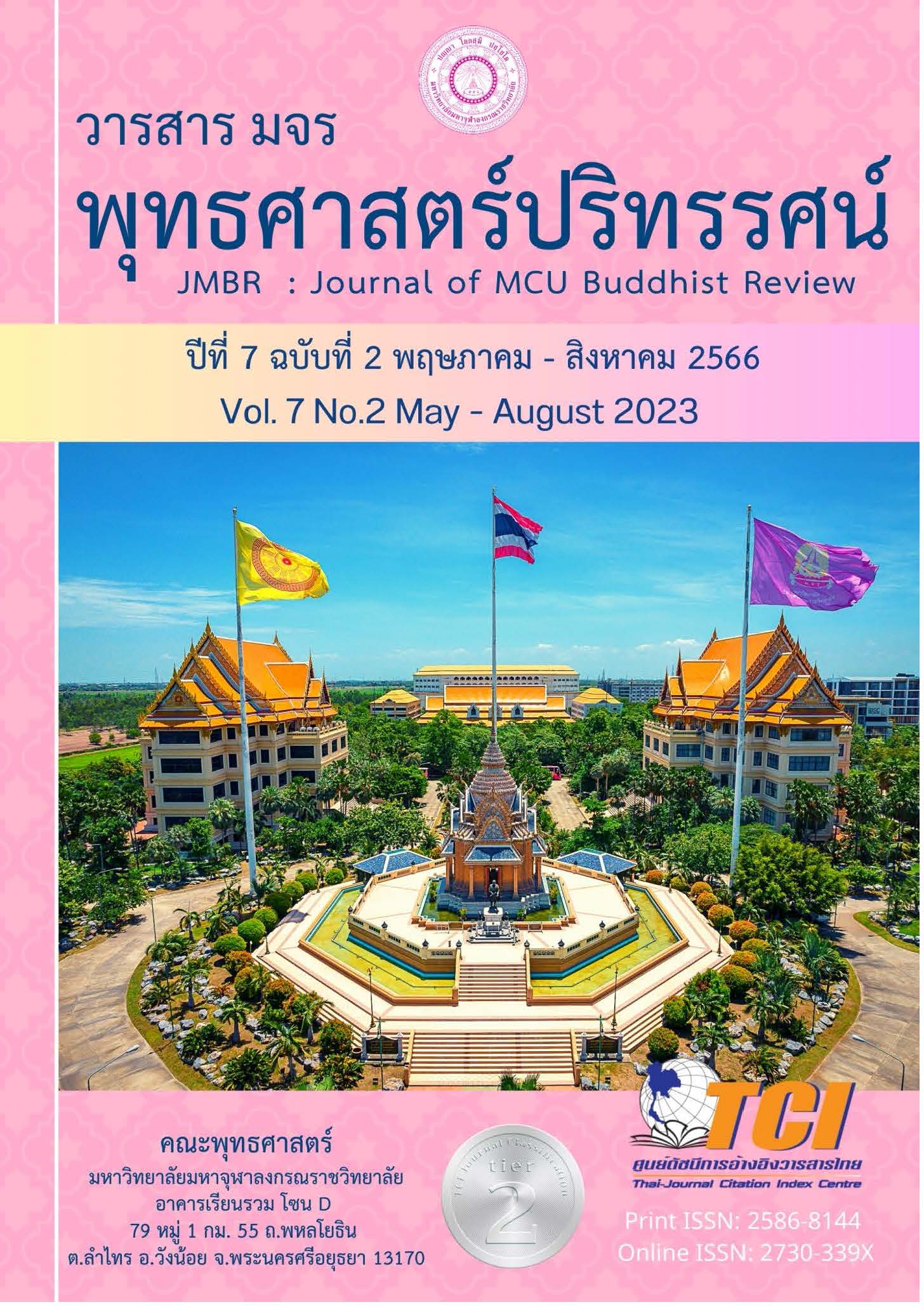การจัดกิจกรรมส่งเสริมการเรียนรู้แหล่งโบราณคดีทางพระพุทธศาสนา สมัยทวารวดีในจังหวัดนครสวรรค์-อุทัยธานี
Main Article Content
บทคัดย่อ
บทความวิจัยนี้มีวัตถุประสงค์ 1) เพื่อศึกษาแนวคิดเรื่องการเรียนรู้ผังแหล่งโบราณคดี 2) เพื่อศึกษาการจัดกิจกรรมส่งเสริมการเรียนรู้แหล่งโบราณคดีทางพระพุทธศาสนาสมัยทวารวดีในจังหวัดนครสวรรค์-อุทัยธานี 3) เพื่อศึกษาประโยชน์จากการจัดกิจกรรมส่งเสริมการเรียนรู้แหล่งโบราณคดีทางพระพุทธศาสนาสมัยทวารวดีในจังหวัดนครสวรรค์-อุทัยธานี เป็นการวิจัยเชิงคุณภาพ ศึกษาพื้นที่จังหวัดนครสวรรค์-อุทัยธานี กลุ่มประชากร 45 คน และการปฏิบัติการร่วมกันด้วยกระบวนการตามวงจรเดมมิง วิเคราะห์และนำเสนอ เชิงพรรณนา
ผลการวิจัยพบว่า 1) แนวคิดเกี่ยวกับทฤษฏีและกระบวนการในการสร้างองค์ความรู้ คือ องค์ความรู้เกิดมาจากจิตที่ส่งผลต่อการกระทำทางกายเรียกว่าพฤติกรรม โดยพฤติกรรมนั้นมาจากแรงกระตุ้นที่ก่อให้เกิดการแสดงพฤติกรรมออกมาภายนอก ซึ่งกระบวนการดังกล่าวเรียกว่าการเรียนรู้ ส่วนการเรียนรู้ของพระพุทธศาสนา การเรียนรู้หรือการศึกษา เกิดมาจากการฝึกฝนผ่าน ศีล สมาธิและปัญญา 2) การจัดกิจกรรมส่งเสริมการเรียนรู้แหล่งโบราณคดีทางพระพุทธศาสนาสมัยทวารวดีในจังหวัดนครสวรรค์-อุทัยธานีได้ดำเนินการจัดผ่านกิจกรรม 3 ประเภท คือ (1) กิจกรรมส่งเสริมประเพณีฟื้นฟู สืบสาน อนุรักษ์ เมืองดงแม่นางเมือง (2) กิจกรรมถอดองค์ความรู้เรื่องเมืองโบราณสมัยทวารวดี (3) กิจกรรมอบรมมัคคุเทศก์ท้องถิ่นเพื่อการเรียนรู้ผังแหล่งโบราณคดีทางพระพุทธศาสนาสมัยทวารวดีในจังหวัดนครสวรรค์-อุทัยธานี โดยใช้กรณีเมืองโบราณดงแม่นางเมือง 3) ผลจากการจัดกิจกรรมก่อให้เกิดผล คือ (1) ผลด้านการท่องเที่ยว (2) ผลด้านการปลูกจิตสำนึกรักษาแหล่งโบราณคดีในชุมชน (3) ผลด้านการสร้างมูลค่าเพิ่มทางเศรษฐกิจให้กับชุมชน
Article Details

อนุญาตภายใต้เงื่อนไข Creative Commons Attribution-NonCommercial-NoDerivatives 4.0 International License.
- บทความที่ได้รับการตีพิมพ์เป็นลิขสิทธิ์ของวารสาร มจร พุทธศาสตร์ปริทรรศน์
- ข้อความใดๆ ที่ปรากฎในบทความที่ได้รับการตีพิมพ์ในวารสาร ถือเป็นความรับผิดชอบของผู้เขียนบทความ และข้อคิดเห็นนั้นไม่ถือว่าเป็นทัศนะและความรับผิดชอบของกองบรรณาธิการวารสาร มจร พุทธศาสตร์ปริทรรศน์
เอกสารอ้างอิง
กรมศิลปากร. (2531). โบราณคดีสี่ภาค. กรุงเทพฯ: หัตถศิลป์.
จี. เซเดส์. (2521). ชนชาติต่าง ๆ ในแหลมอินโดจีน. แปลโดย ปัญญา บริสุทธิ์. กรุงเทพฯ: มูลนิธิโครงการ ตำราสังคมศาสตร์และมนุษย์ศาสตร์.
พระครูปลัดธีระชัย อชิโต. (2560). รูปแบบการเรียนรู้เชิงพุทธในศตวรรษที่ 21. วารสารสถาบันวิจัยญาณสังวร. 8(2), 71-82.
พระราชวรมุนี (ประยุทธ์ ปยุตฺโต). 2528. ปรัชญาการศึกษาไทย ฉบับแก้ไขรวบรวมใหม่. พิมพ์ครั้งที่ 3. กรุงเทพฯ: ม.ป.ท.
พระธรรมปิฎก (ป.อ. ปยุตโต). (2540). พระพุทธศาสนาในอาเซีย. กรุงเทพฯ: ธรรมสภา.
มหาจุฬาลงกรณราชวิทยาลัย. (2539). พระไตรปิฎกภาษาไทย ฉบับมหาจุฬาลงกรณราชวิทยาลัย. กรุงเทพฯ: มหาจุฬาลงกรณราชวิทยาลัย.
เสถียร โพธินันทะ. (2535). ประวัติศาสตร์พระพุทธศาสนา. กรุงเทพฯ: มหามกุฏราชวิทยาลัย.
ริเรืองรอง รัตนวิไลสกุล. (2540). มนุษยสัมพันธ์. พิมพ์ครั้งที่ 3. กรุงเทพฯ: สถาบันเทคโนโลยี พระจอมเกล้าธนบุรี.
สุมน อมรวิวัฒน์. (2546). แนวคิดเกี่ยวกับการบูรณาการการศึกษา ศาสนาและวัฒนธรรม ใน วิถีการเรียนรู้ของคนไทย: ประมวลสาระจากกาประชุมและรวมข้อเขียนจากนักคิด. กรุงเทพฯ: โครงการวิถีการเรียนรู้ของคนไทย.
สุจิตต์ วงศ์เทศ. (2548). คนไทยมาจากไหน?. กรุงเทพฯ: สำนักพิมพ์มติชน.
Sperling, A. P. (1967). Psychology Made Simple. Great Britain: W. H. Allen & Company, Inc..
Hilgard, E. R. (1962). Introduction to Psychology. United States of America: Harcourt Brace & World, Inc..
Morgan, C. T. (1956). Introduction to Psychology. United States of America: McGRAW-Hill Book Company, Inc..
KaGan, J. & Havemann, E. (1972). Psychology: An Introduction. 2nd edition. United States of America: Harcourt Brace Jovanovich, Inc..


